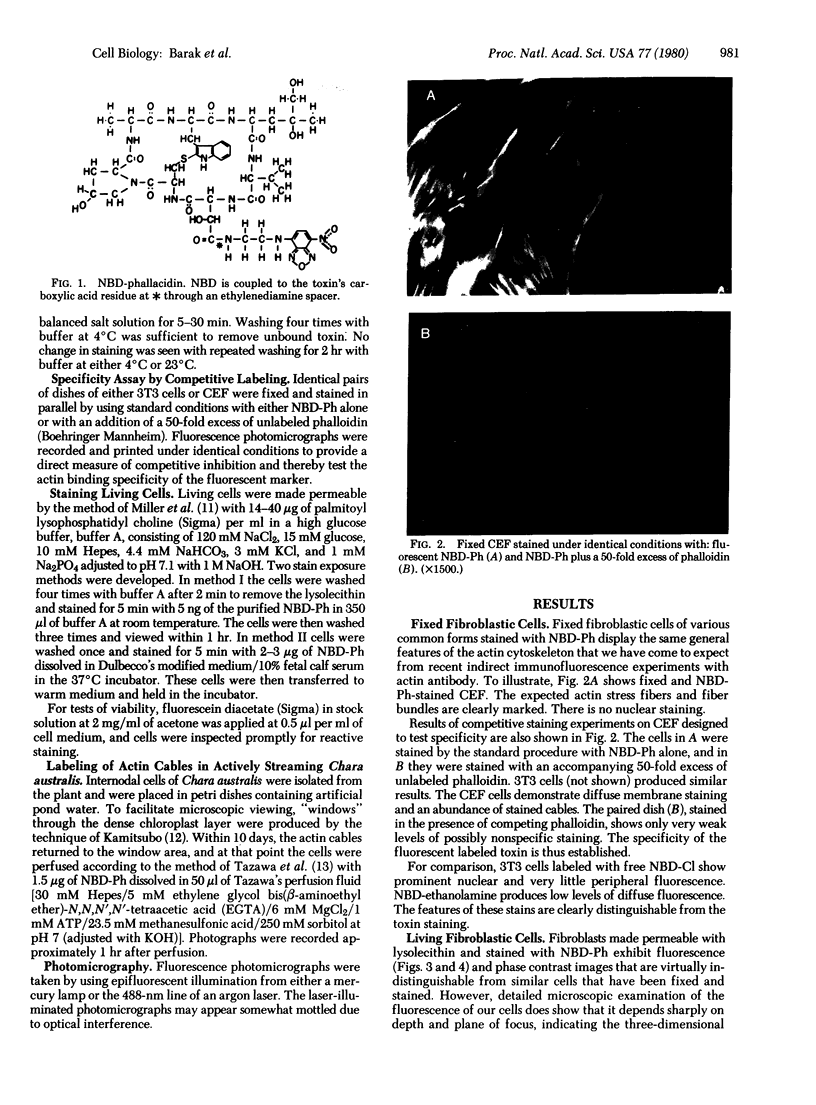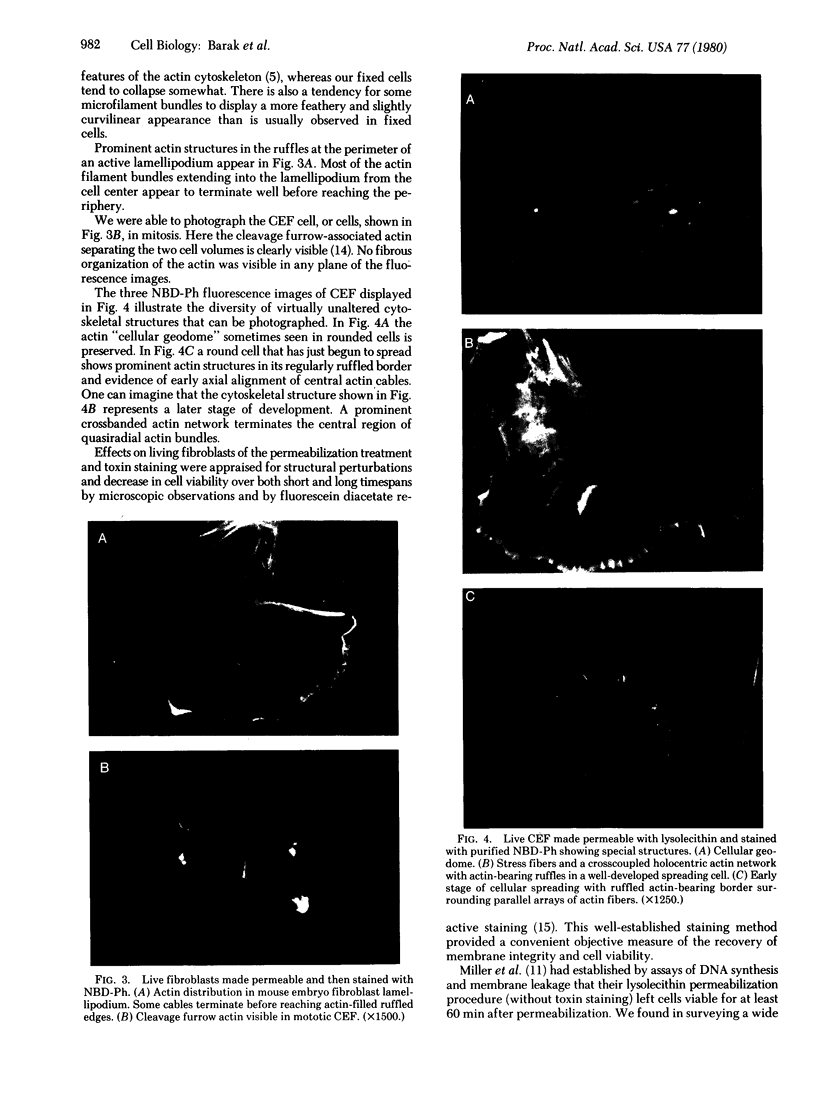Abstract
An active fluorescent derivative of the actin-binding mushroom toxin phallacidin has been synthesized. Convenient methods were developed to stain actin cytoskeletal structures in living and fixed cultured animal cells and actively streaming algal cells. Actin binding specificity was demonstrated by competitive binding experiments and comparative staining of well-known structures. Large populations of living animal cells in culture were readily stained by using a relatively mild lysolecithin permeabilization procedure facilitated by the small molecular size of the label. Actin in animal cells was stained stress fibers, ruffles, the cellular geodome, and in diffuse appearing distributions apparently associated with the plasma membrane. Staining of actin cables in algae with nitrobenzoxadiazole (NBD)-phallacidin did not inhibit cytoplasmic streaming. NBD-phallacidin provides a convenient actin-specific fluorescent label for cellular cytoskeletal structures with promise for use in studies of actin dynamics in living systems.
Full text
PDF




Images in this article
Selected References
These references are in PubMed. This may not be the complete list of references from this article.
- Franke W. W., Schmid E., Osborn M., Weber K. Intermediate-sized filaments of human endothelial cells. J Cell Biol. 1979 Jun;81(3):570–580. doi: 10.1083/jcb.81.3.570. [DOI] [PMC free article] [PubMed] [Google Scholar]
- Fujiwara K., Pollard T. D. Fluorescent antibody localization of myosin in the cytoplasm, cleavage furrow, and mitotic spindle of human cells. J Cell Biol. 1976 Dec;71(3):848–875. doi: 10.1083/jcb.71.3.848. [DOI] [PMC free article] [PubMed] [Google Scholar]
- Kamitsubo E. A 'window technique' for detailed observation of characean cytoplasmic streaming. Exp Cell Res. 1972 Oct;74(2):613–616. doi: 10.1016/0014-4827(72)90430-2. [DOI] [PubMed] [Google Scholar]
- Kreis T. E., Winterhalter K. H., Birchmeier W. In vivo distribution and turnover of fluorescently labeled actin microinjected into human fibroblasts. Proc Natl Acad Sci U S A. 1979 Aug;76(8):3814–3818. doi: 10.1073/pnas.76.8.3814. [DOI] [PMC free article] [PubMed] [Google Scholar]
- Lazarides E., Weber K. Actin antibody: the specific visualization of actin filaments in non-muscle cells. Proc Natl Acad Sci U S A. 1974 Jun;71(6):2268–2272. doi: 10.1073/pnas.71.6.2268. [DOI] [PMC free article] [PubMed] [Google Scholar]
- Miller M. R., Castellot J. J., Jr, Pardee A. B. A general method for permeabilizing monolayer and suspension cultured animal cells. Exp Cell Res. 1979 May;120(2):421–425. doi: 10.1016/0014-4827(79)90404-x. [DOI] [PubMed] [Google Scholar]
- Nagai R., Hayama T. Ultrastructure of the endoplasmic factor responsible for cytoplasmic streaming in Chara internodal cells. J Cell Sci. 1979 Apr;36:121–136. doi: 10.1242/jcs.36.1.121. [DOI] [PubMed] [Google Scholar]
- Nothnagle E. A., Webb W. W. Barrier filter for fluorescence microscopy of strongly autofluorescent plant tissues. Application to actin cables in Chara. J Histochem Cytochem. 1979 May;27(5):1000–1002. doi: 10.1177/27.5.90068. [DOI] [PubMed] [Google Scholar]
- Palevitz B. A., Ash J. F., Hepler P. K. Actin in the green alga, Nitella. Proc Natl Acad Sci U S A. 1974 Feb;71(2):363–366. doi: 10.1073/pnas.71.2.363. [DOI] [PMC free article] [PubMed] [Google Scholar]
- Rein A., Rubin H. Effects of local cell concentrations upon the growth of chick embryo cells in tissue culture. Exp Cell Res. 1968 Mar;49(3):666–678. doi: 10.1016/0014-4827(68)90213-9. [DOI] [PubMed] [Google Scholar]
- Rotman B., Papermaster B. W. Membrane properties of living mammalian cells as studied by enzymatic hydrolysis of fluorogenic esters. Proc Natl Acad Sci U S A. 1966 Jan;55(1):134–141. doi: 10.1073/pnas.55.1.134. [DOI] [PMC free article] [PubMed] [Google Scholar]
- Sanger J. W. Changing patterns of actin localization during cell division. Proc Natl Acad Sci U S A. 1975 May;72(5):1913–1916. doi: 10.1073/pnas.72.5.1913. [DOI] [PMC free article] [PubMed] [Google Scholar]
- Taylor D. L., Wang Y. L. Molecular cytochemistry: incorporation of fluorescently labeled actin into living cells. Proc Natl Acad Sci U S A. 1978 Feb;75(2):857–861. doi: 10.1073/pnas.75.2.857. [DOI] [PMC free article] [PubMed] [Google Scholar]
- Wehland J., Osborn M., Weber K. Phalloidin-induced actin polymerization in the cytoplasm of cultured cells interferes with cell locomotion and growth. Proc Natl Acad Sci U S A. 1977 Dec;74(12):5613–5617. doi: 10.1073/pnas.74.12.5613. [DOI] [PMC free article] [PubMed] [Google Scholar]
- Wieland T., Faulstich H. Amatoxins, phallotoxins, phallolysin, and antamanide: the biologically active components of poisonous Amanita mushrooms. CRC Crit Rev Biochem. 1978 Dec;5(3):185–260. doi: 10.3109/10409237809149870. [DOI] [PubMed] [Google Scholar]
- Wieland T. Modification of actins by phallotoxins. Naturwissenschaften. 1977 Jun;64(6):303–309. doi: 10.1007/BF00446784. [DOI] [PubMed] [Google Scholar]
- Williamson R. E. Actin in the alga, Chara corallina. Nature. 1974 Apr 26;248(5451):801–802. doi: 10.1038/248801a0. [DOI] [PubMed] [Google Scholar]
- Wulf E., Deboben A., Bautz F. A., Faulstich H., Wieland T. Fluorescent phallotoxin, a tool for the visualization of cellular actin. Proc Natl Acad Sci U S A. 1979 Sep;76(9):4498–4502. doi: 10.1073/pnas.76.9.4498. [DOI] [PMC free article] [PubMed] [Google Scholar]
- Yocum R. R. New laboratory scale purification of beta-amanitin from American Amanita phalloides. Biochemistry. 1978 Sep 5;17(18):3786–3789. doi: 10.1021/bi00611a018. [DOI] [PubMed] [Google Scholar]
- Yocum R. R., Simons D. M. Amatoxins and phallotoxins in Amanita species of the northeastern United States. Lloydia. 1977 Mar-Apr;40(2):178–190. [PubMed] [Google Scholar]











